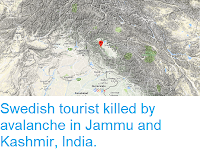Five people are known to have died and another five are still missing after an avalanche swept two vehicles from a road in the Ladakh Region of Jammu and Kashmir, India, on Friday 18 January 2019. The incident happened at about 7.00 am local time on the Khardung La Pass, which at 5300 m is one of the highest mountain passes on Earth. The vehicles are reported to have been buried under about six meters of snow, and there is thought to be little chance of finding any survivors. The ten who died are reported to have been employees of the Border Roads Organisation engaged in snow clearing operations on the pass.
Rescue workers at the site of a fatal avalanche on the Khardung La pass in Jammu and Kashmir on 18 January 2019. SNS.
Avalanches are caused by the mechanical failure of snowpacks;
essentially when the weight of the snow above a certain point exceeds
the carrying capacity of the snow at that point to support its weight.
This can happen for two reasons, because more snow falls upslope,
causing the weight to rise, or because snow begins to melt downslope,
causing the carrying capacity to fall. Avalanches may also be triggered
by other events, such as Earthquakes or rockfalls. Contrary to what is
often seen in films and on television, avalanches are not usually
triggered by loud noises. Because snow forms layers, with each layer
typically occurring due to a different snowfall, and having different
physical properties, multiple avalanches can occur at the same spot,
with the failure of a weaker layer losing to the loss of the snow above
it, but other layers below left in place - to potentially fail later.
Diagrammatic representation of an avalanche, showing how layering of snow contributes to these events. Expedition Earth.
See also...
Follow Sciency Thoughts on Facebook.








